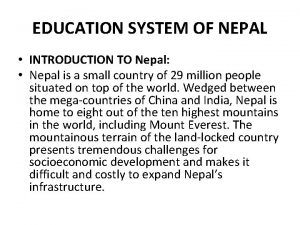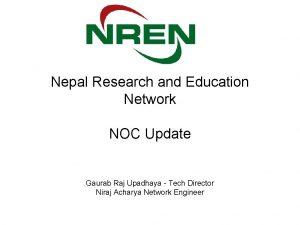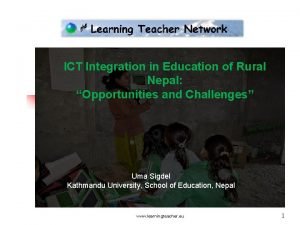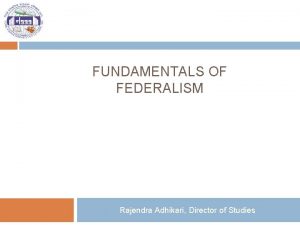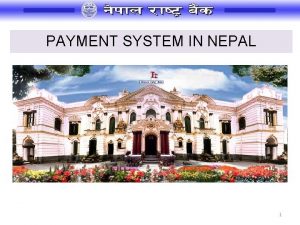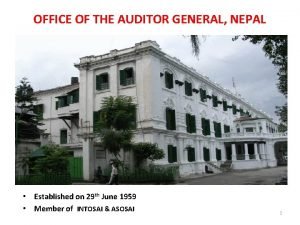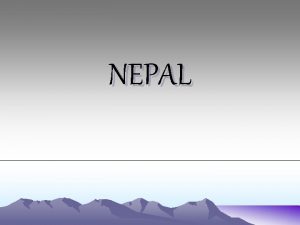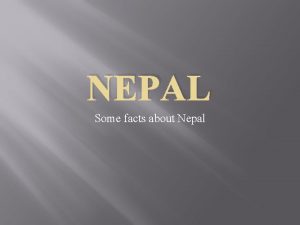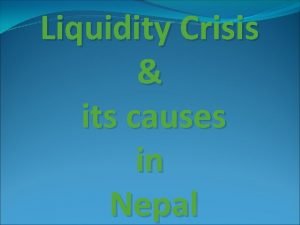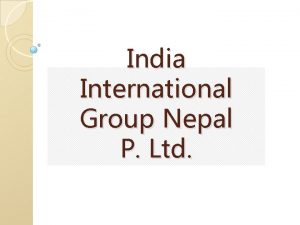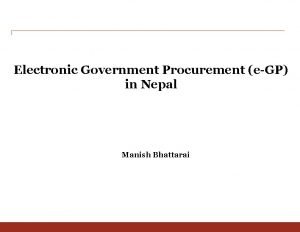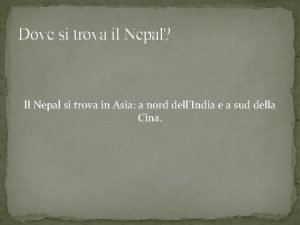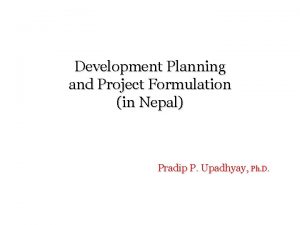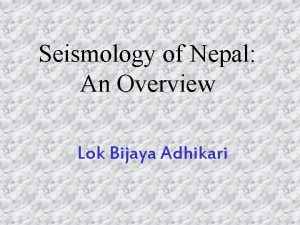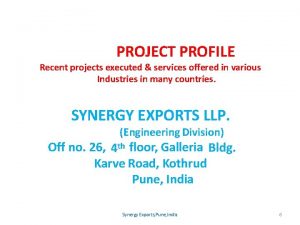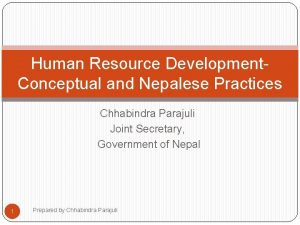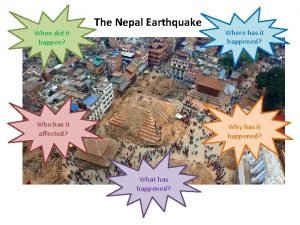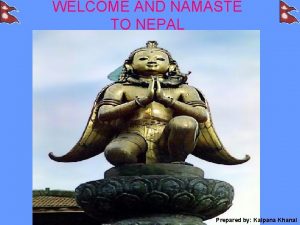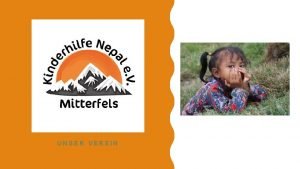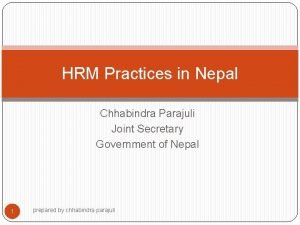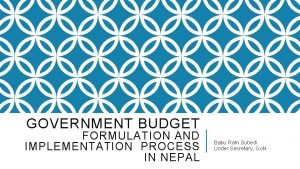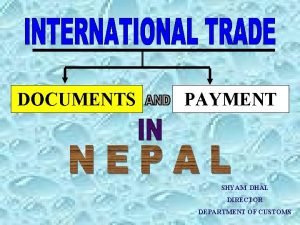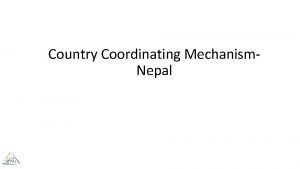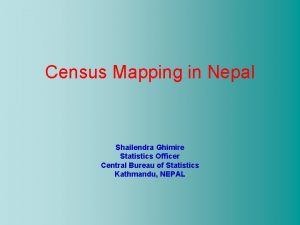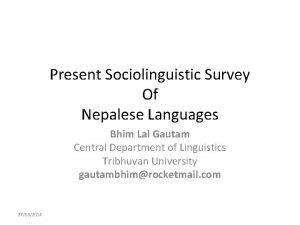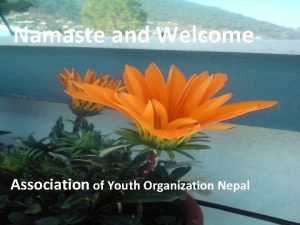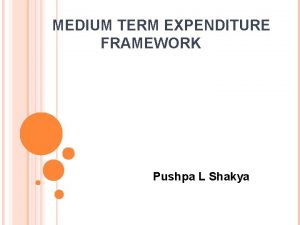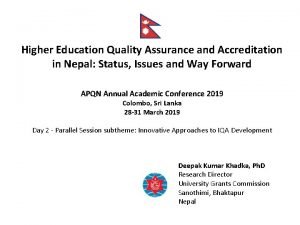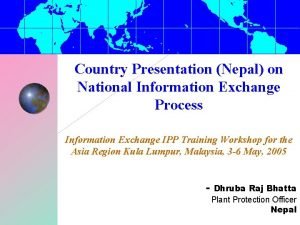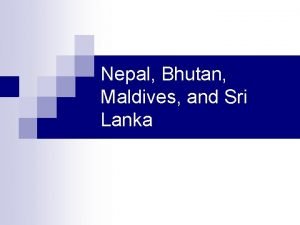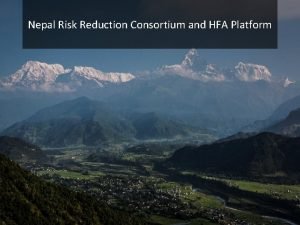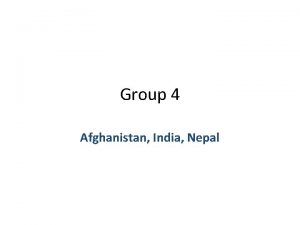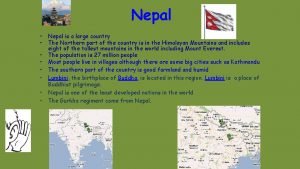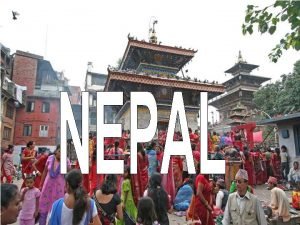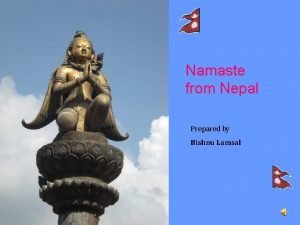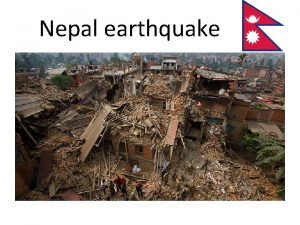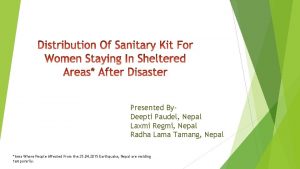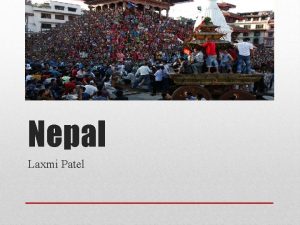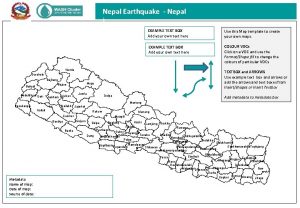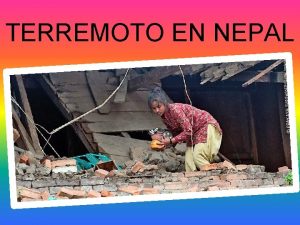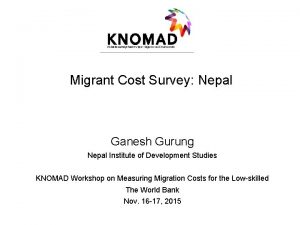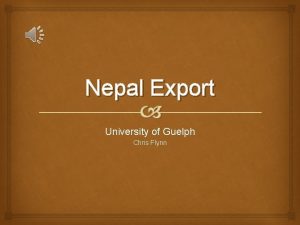EDUCATION SYSTEM OF NEPAL INTRODUCTION TO Nepal Nepal








































- Slides: 40

EDUCATION SYSTEM OF NEPAL • INTRODUCTION TO Nepal: • Nepal is a small country of 29 million people situated on top of the world. Wedged between the mega-countries of China and India, Nepal is home to eight out of the ten highest mountains in the world, including Mount Everest. The mountainous terrain of the land-locked country presents tremendous challenges for socioeconomic development and makes it difficult and costly to expand Nepal’s infrastructure.

BACKGROUND/HISTORY • The Nepalese education system was traditionally oriented towards the Indian system, and was known as the three-tier sixteen-year education system: 10 years of primary and secondary education, followed by 4 years of college level studies and 2 years of master's education.

POLICY OF NEPAL EDUCATION SYSTEM • “Educated, civilized, healthy and capable human resource, social justice, transformation and prosperity” is the primary vision of the policy. The policy envisions to catapult the entire education system on par with the guidelines of the federal democratic republic system of the country.

LITERACY RATE Overall literacy rate in Nepal is 67. 9% • Education in Nepal was long based on homeschooling and gurukulas. The first formal school (Durbar School), established by Jung Bahadur Rana in 1853, was intended for the elite. . There were 49, 000 schools in 2010, and by 2015 the overall adult literacy rate was 63. 9 percent (males 76. 4 percent and females 53. 1 percent)

CONT. . • In 2018, adult literacy rate for Nepal was 67. 9 %. Adult literacy rate of Nepal increased from 20. 6 % in 1981 to 67. 9 % in 2018 growing at an average annual rate of 36. 06%.

DROP OUT RATE • 4. 8 % Status of drop out in Nepal • Still 4. 8 % of students are leaving schools every year and repetition rate is also high which has been one of the major problems in the field of education. Nepal government Ministry of Education is also investing huge amount on primary education but the result is troublesome.

DROP OUT RATE UNTIL 2015

LEVELS OF EDUCATION Elementary Education: Until 2016, elementary education in Nepal lasted for five years – from grade 1 to grade 5 (ages five to nine). However, a new education bill passed in 2016 extended the elementary education cycle and established a new system of compulsory basic education that is meant to be accessible to every child in Nepal free of charge at public schools. Compulsory basic education now lasts eight years (grades 1 to 8).

CONT. . In addition, children have the option to enroll in public ‘early childhood development centers’ or private kindergartens before entering elementary school at the age of five. Access to early childhood education, however, remains problematic in many parts of the country and participation rates are low.

Secondary Education: Admission into secondary education is based on passing the final district-level examination at the end of grade 8. • Secondary education takes place in 2 stages. Grades 9 to 10 follow a common academic curriculum leading to a school leaving certificate. During grades 11 to 12 though, there are opportunities to follow separate streams in commerce, education, humanities or science, and to receive a higher education certificate.

• Higher education: • Higher education in Nepal did not evolve before the 20 th century. The first higher education institution, Trichandra College, was established in 1918 but was reserved for privileged members of the ruling Rana family. The first university that was open to the wider public, Tribhuvan University, was not founded before 1959 and remained the only university in Nepal until 1986. Today, Tribhuvan University is still the largest university in Nepal and enrolls about 79 percent of all Nepali students (2015/16).

CONT. . • Academic programs of bachelor's degree and above are regarded as higher education in Nepal. However, universities continue to offer proficiency certificate level (PCL) - programs equivalent to higher secondary education (grades 11 and 12). Duration of bachelor's program is 3 to 5 years and masters level – 2 years.

EXAMINATION SYSTEM A Basic Level Examination (BLE) is given on grade eight while a national Secondary Education Exam (SEE) examination is conducted at the end of grade 10, while completing the Grade 12 examination leads to the School Leaver's Certificate. The National Examinations Board (NEB) supervises all BLE, SEE and 12 th grade exams.

CONT. . • The Secondary Education Examination, abbreviated SEE, is the final examination in the secondary school system of Nepal. National Examination Board upgraded from what was previously known as School Leaving Certificate (Nepal) or SLC. Every student must take this examination for completing the 10 th grade of their study (According to new Education Act) before they join higher secondary or intermediate level education (12 th grade). The SEE examination is said to be scheduled in March of every year. The government has a great determination that the new grading system that has been recently implemented in the SLC examination will help the country to increase the literacy rate.

• . As the new Education Act, 2016 (2073) has been implemented, the SLC examination will be taken place in Grade 10 as national level examination whereas the examination of Grade 10 will be known as Secondary Education Examination (S. E. E). This new Education Act was implemented from 2017 March with 538, 000 students taking it.

BASIC GRADING The Percentage obtained Grade description Grade point >= 90% A+ Outstanding 4 >=80% AND <90% A Excellent 3. 6 >=70% AND <80% B+ Very Good 3. 2 >=60% AND <70% B Good 2. 8 >=50% AND <60% C+ Above Average 2. 4 >=40% AND <50% C Average 2. 0 >=25% AND <40% D Below Average 1. 6 >=1% AND <25% E Insufficient 0. 8 0 N Null

• UNIVERSITY Tribhuvan University (TU), one of the oldest and largest university of Nepal, has been launching the semester system in general masters' program from the year 2014 at Central Campus in Kirtipur and from the year 2017 at Kathmandu Valley and planning to launch across the country from the year 2018.

GRADING FOR UNIVERSITY LEVEL • • G. P. A. - Letter Grade 3. 60 -4. 00 – A+ • (Including 3. 60) • 3. 10 -3. 60 - A • 2. 80 -3. 10 - B+ • 2. 40 -2. 80 - B • 2. 00 -2. 40 - C+ • 1. 60 -2. 00 - C • 1. 20 -1. 60 - D+ • 0. 80 -1. 20 - D *Note* Scores less than 0. 80 GPA are not Acceptable anywhere !

CURRICULUM OF NEPAL • Government schools use Janak textbooks, and private schools use reference books such as Green, Koseli , Ekta , Read More, Reliant, Asia, and Vidyarthi. Government schools perform poorly in the SLC exam, presently SEE exam, due to the lack of skilled teachers, textbooks, and the Ministry of Education's neglect of textbook reform.

CURRICULUM • Elementary or primary level: • According to the new syllabus, classes 1– 3 have integrated Nepali, English, Mero Serofero and Mathematics subjects into an integrated curriculum. According to the information officer of the center Bhattarai, the local level should prepare the mother tongue and local subjects and teach five hours a week.

CONT. . • Similarly, the subject of human value education has been added in the curriculum of classes 4 to 8. At present, there is no moral education in grades 6 -8 and the teaching of moral education in grades 6 -8. Ethical education is a human value education. The business, business and technology topics currently being taught in grades 6 -8 are excluded from the national curriculum and are included in the local curriculum.

COMPULSORY SUBJECTS • • Nepali English Science and Environment Mathematics Social Studies and Population Education Occupation, Business and Technology Education Moral Education Health and Physical Education

OPTIONAL SUBJECTS • • Sanskrit Extra English and other languages Computer Education Geography and History Education Extra Mathematics Business Education Technology Education Office Practice and Accountancy

• SECONDARY LEVEL: The topics of compulsory health, population, and environment are eliminated in classes 9 -10. It is now reduced to seven out of eight topics. In the past, health, population, and environment were divided into three separate subjects and included as optional subjects. "Students can choose either health or population or the environment as an optional subject, " he said. Compulsory Nepali subjects have been added in both Classes 11 and 12.

HIGHER LEVEL Bachelor's/Undergraduate Level (b) Master's Level/Graduate/Degree Level (c) Post Graduate, M. Phil. Level (d) Ph. D. Doctoral Level Higher education in Nepal, like elsewhere in the world, is the sole responsibility of and administered by universities and institutions of higher learning these examinations are supervised under university authority and gave degrees to students in their respect fields after passing all semesters of the program.

ACADEMIC CALENDER • SCHOOL YEAR IN NEPAL ( PRIVATE SCHOOLS)

• Begin: • Mid-April (coincides with the first week of the start of Nepali New year) • End: • Mid-March (after final exams) • Exams: • At the end of each term (1 term= 4 months) • July - August First Terminal Examinations • November - December Second Terminal Examinations • March - April Third Terminal Examinations (Finals) • Holidays: • October Dashain & Tihar Festivals (biggest Festivals in Nepal) • January Winter holidays • March - April Session Break holidays

TECHNICAL AND VOCATIONAL EDUCATION • There a variety of formal and informal TVET programs on offer in Nepal’s education system. TVET is critical for human capital development in Nepal, especially in light of the country’s looming “youth unemployment time bomb. ” Youth unemployment is rising quickly, and many Nepali youths enter the labor market without marketable skills (or out-migrate from Nepal). The government Programs are offered in a multitude of fields, ranging from medical lab technology to agriculture, nursing, culinary arts, automotive technology, hotel management or computer technology. The most common types of programs available are:

• Short-Term Certificate Programs: • Trade schools, technical schools, and training centers offer short-term TVET programs that usually have no specific admission requirements and last from one week to 10 months, depending on the program.

• Formal Secondary-Level Programs: • Formal programs at the secondary level usually require at least completion of grade 10 (respectively the SLC) for admission, but may also entail additional entrance examinations. Programs are between 15 and 29 months in length, concluding with a final examination and lead to a Technical School Leaving Certificate (TSLC) awarded by CTEVT.

• Diploma and Technician Certificate Programs • Diplomas and Technician Certificate programs are more advanced and usually require three years of full-time study to complete. They typically have a greater focus on theoretical classroom instruction and go beyond the TSLC in scope and intent. Admission is based on completion of grade ten (SLC) or the TSLC and often also requires passing of an entrance examination.

TEACHER’S EDUCATION • Educational requirements for teachers in Nepal vary by level of education. While it is unknown how the current reforms in basic and secondary education will impact requirements for teachers, elementary school teachers could, as of recently, still teach with a 10 -year Secondary School Leaving Certificate (SLC), as long as they also completed a practical teacher training program of at least ten months. Lower-secondary teachers could teach with a Proficiency Certificate in Education or a 10+2 upper-secondary qualification plus 10 months of practical training. Upper-secondary teachers, on the other hand, require a Bachelor of Education degree. These degrees can be earned either as a direct-entry degrees after high school, shortened two-year programs for holders of a Proficiency Certificate in education, or as a one-year “to-up” qualification for holders of bachelor’s degrees in other disciplines.


ADMINISTRATION • The Ministry of Education is responsible for managing educational activities in Nepal. The Minister of Education (assisted by the state or assistant minister) is the political leader of the ministry. The ministry, as a part of the government, is headed by the Secretary of Education and consists of a central national office and other offices at the regional and district levels. The central office is primarily responsible for policy development, planning, monitoring, and evaluation.

CONT: • The National Center for Educational Development (NCED) is Nepal's teacher-training body. It has 34 educational training centers (ETCs) to provide pedagogical support for teachers. • Nepal has two primary types of schools: community and institutional. Community (public) schools receive government grants, and institutional (private) schools are self-funded. Institutional schools are non-profit trusts or companies.

FACILITIES FOR STUDENTS • • • Computer facility in classroom teaching. Whiteboard in classrooms. Board markers for white board. Multimedia in classrooms. Separate computer classrooms. Library in schools. Adequate books in library. Science lab in school. Facilities of additional coaching classes.

FACILITIES FOR TEACHERS • A person who enters the teacher service remains teacher for that specific service for life. • providing free training facilities to un-trained teachers.

FUNFACTS ABOUT NEPAL • The current Nepali Year in Nepal calendar is 2076 Bigram Samba. Nepali Calendar is approximately 56 years and 8 and months ahead of the English Calendar known as Gregorian Calendar or AD. Nepali Calendar in Nepal is called as Nepal Patrol. They celebrate the new year on April 13 th. • In Nepal students call their teacher “ shikshak”

• The Nepal flag is the only national flag that is not quadrilateral in shape. It is made of two triangles. The triangles are said to represent Hinduism and Buddhism. They also represent the Himalayan Mountains.

THANKS
 Education system in nepal
Education system in nepal Noc update
Noc update Ict in education in nepal
Ict in education in nepal यगत
यगत Payment system in nepal
Payment system in nepal Difference between formal education and als
Difference between formal education and als Difference between health education and propaganda
Difference between health education and propaganda Types of extension education
Types of extension education Auditor general in nepali
Auditor general in nepali Nepal zastava
Nepal zastava Where is napal
Where is napal Let live in peace
Let live in peace Causes of liquidity crisis in nepal
Causes of liquidity crisis in nepal Iig nepal
Iig nepal Himalaya malaysia
Himalaya malaysia Ppmis
Ppmis Nepal dove si trova
Nepal dove si trova Plan formulation process in nepal
Plan formulation process in nepal Palliative care in nepal
Palliative care in nepal Chapter 25 human geography of south asia
Chapter 25 human geography of south asia Seismology nepal
Seismology nepal Everest solvent pvt ltd nepal
Everest solvent pvt ltd nepal Business ethics in nepali
Business ethics in nepali Hr practices in nepal
Hr practices in nepal Crop calendar nepal
Crop calendar nepal Sexual harassment at workplace act nepal
Sexual harassment at workplace act nepal When did nepal earthquake happen
When did nepal earthquake happen Nepal flag
Nepal flag Kinderhilfe nepal mitterfels
Kinderhilfe nepal mitterfels Hrm practices in nepal
Hrm practices in nepal Process of government budget formulation
Process of government budget formulation Pragyapan patra number
Pragyapan patra number Ccms nepal
Ccms nepal Ea map nepal
Ea map nepal Languages of nepal
Languages of nepal Cdep nepal
Cdep nepal Youth organization in nepal
Youth organization in nepal Mtef nepal
Mtef nepal Qaa in nepal
Qaa in nepal Countercyclical buffer in nepal
Countercyclical buffer in nepal Plant protection directorate nepal
Plant protection directorate nepal
